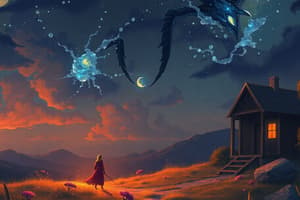Podcast
Questions and Answers
What type of conflict involves a character struggling with their own thoughts and feelings?
What type of conflict involves a character struggling with their own thoughts and feelings?
- Character vs. Nature
- Character vs. Society
- Internal Conflict (correct)
- External Conflict
Pathos is a literary device used to make the reader feel anger towards a character or event.
Pathos is a literary device used to make the reader feel anger towards a character or event.
False (B)
What is the literary device where an author provides hints about future events?
What is the literary device where an author provides hints about future events?
foreshadowing
When a character says one thing but means the opposite, it is called ______ irony.
When a character says one thing but means the opposite, it is called ______ irony.
Match the following plot structure terms with their descriptions:
Match the following plot structure terms with their descriptions:
If a story has a suspenseful feeling, which element is being used by the author?
If a story has a suspenseful feeling, which element is being used by the author?
A symbol in literature can only be a physical object.
A symbol in literature can only be a physical object.
What is the central message or idea an author conveys through a story?
What is the central message or idea an author conveys through a story?
Flashcards
External Conflict
External Conflict
A struggle between a character and an outside force, including other people, nature, society, or supernatural elements.
Internal Conflict
Internal Conflict
A struggle within a character's own mind, often involving conflicting desires, beliefs, or emotions.
Foreshadowing
Foreshadowing
A clue or hint placed by the author to suggest a future event in the story.
Theme
Theme
Signup and view all the flashcards
Symbol
Symbol
Signup and view all the flashcards
Situational Irony
Situational Irony
Signup and view all the flashcards
Verbal Irony
Verbal Irony
Signup and view all the flashcards
Tone
Tone
Signup and view all the flashcards
Study Notes
Short Story Analysis Study Notes
-
Protagonist vs. Antagonist: Identifying the main character (protagonist) and the character(s) opposing them (antagonist) is crucial for understanding the story's conflict.
-
Types of Conflict:
- Internal Conflict: A struggle within a character (e.g., character vs. self).
- External Conflict: A struggle between a character and an outside force:
- Character vs. Character(s)
- Character vs. Nature
- Character vs. Society
- Character vs. Supernatural
-
Pathos: A literary device used to evoke pity, compassion, or sympathy in the reader toward a character or event.
-
Foreshadowing: Hints or clues in a story that suggest future events, helping readers anticipate what might happen.
-
Irony: A contrast between expectation and reality.
- Situational Irony: An event occurs that is the opposite of what is expected.
- Verbal Irony: A character says something that means the opposite of what is literally stated (often sarcasm).
-
Theme: The central message or main idea the author conveys through the story's events and characters.
-
Symbol: Something tangible (object, animal, person) representing an abstract idea or concept. Examples: A red rose symbolizes love; a raven symbolizes death.
-
Ironic Twist: A surprising ending that is the opposite of what is expected.
-
Tone vs. Mood:
- Tone: The author's attitude toward the story's subject matter (e.g., suspenseful, humorous, serious).
- Mood: The emotional feeling a reader experiences while reading the story. The author creates the tone; the reader experiences the mood.
-
Plot Structure Diagram:
- Exposition: Introduces characters, setting, and basic situation.
- Rising Action: Events leading to the climax.
- Climax: The turning point of the story, the most intense moment.
- Falling Action/Denouement: Events following the climax, leading to resolution.
- Resolution: The final outcome and conclusion of the story.
- Inciting Incident: The event that initiates the plot.
-
Figurative Language: Various literary devices to create imagery and meaning beyond literal interpretation.
- Metaphor: A direct comparison of unlike things without using "like" or "as."
- Simile: A comparison of unlike things using "like" or "as."
- Hyperbole: An extreme exaggeration.
- Alliteration: Repetition of consonant sounds at the beginning of words.
- Allusion: A reference to a historical or literary figure, event, or place.
Studying That Suits You
Use AI to generate personalized quizzes and flashcards to suit your learning preferences.




